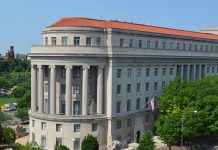According to a November 10 White House fact sheet, the Biden administration’s newly proposed Federal Supplier Climate Risks and Resilience Rule would require major federal contractors and suppliers to set emissions reductions goals that are aligned with the Paris Agreement. They would also be required to publicly disclose their greenhouse gas emissions and climate-related financial risks.
The administration is seeking to drive the United States, one of the world’s largest buyers of goods and services, toward its sustainability goals.
“The United States became the first government to require that our major federal suppliers disclose their emissions and climate risks, and set targets for themselves that are aligned with the Paris Agreement,” Biden said during the global climate conference known as COP27 that took place from November 6 to November 20 in Egypt. “As the world’s largest customer, with more than [$630 billion] in spending last year, the United States government is putting our money where our mouth is to strengthen accountability for climate risk and resilience.”
Depending on annual federal obligations, contractors and large suppliers may be required to disclose scope 1, scope 2, or scope 3 emissions under the proposed rule. Scope 1 includes any direct emissions from the company, such as controlled facilities; scope 2 includes emissions associated with purchased or acquired energy; and scope 3 are all emissions throughout the value chain that are not categorized in scope 2, including procurement and travel.
Over 50% of federal contractors already disclose climate-related information, but the administration would very much like that to be 100%. Meanwhile, 18,700 companies around the world voluntarily disclose emissions and climate risk through CDP (formerly the Carbon Disclosure Project), and 4,000 global companies have set science-based goals to reduce emissions.
However, given that the world has repeatedly failed to meet emissions reductions targets, these efforts clearly have not been enough. Scenarios modelling how to limit global temperature rises to 1.5°C require emissions to peak by 2025, before falling 43% by 2030 on 2019 levels. Global emissions rose by a record 5.5% in 2021.
Many purchasing organizations are focusing on supplier emissions as part of broader sustainability goals, but others have been hesitant to implement plans while they weigh requirements and costs, according to Simon Geale, Executive Vice President of Procurement at supply chain consultancy Proxima.
“The hidden reality is that many more are not, because they are not feeling the pressure and in many cases are not sure what will be required of them,” Geale said.
Biden’s Federal Sustainability Plan, of which the proposed rule is a part, has set the goal to achieve net-zero emissions in procurement by 2050. This would account for approximately 85% of federal supply chain-related emissions. According to the White House fact sheet, the federal supply chain contributes massively to emissions — more than double the emissions of operating the federal government’s 300,000 buildings and 600,000 vehicles.






















